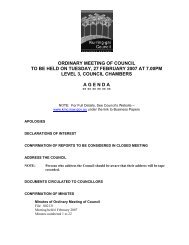Pymble Business Park - Ku-ring-gai Council
Pymble Business Park - Ku-ring-gai Council
Pymble Business Park - Ku-ring-gai Council
Create successful ePaper yourself
Turn your PDF publications into a flip-book with our unique Google optimized e-Paper software.
13.6 NO NET LOSS OF BIODIVERSITY<br />
(continued)<br />
- Where the removal or thinning/underscrubbing of a large<br />
patch of a threatened community is unavoidable, the more<br />
formal offsetting mechanisms should be considered.<br />
Note: It is strongly recommended that for developments conside<strong>ring</strong><br />
offsetting that pre-lodgement discussions are held with <strong>Council</strong>.<br />
7 Any proposal involving a formal offsetting mechanism, on or off site,<br />
must be in accordance with the following principles:<br />
i) Principle 1: Avoid, Minimise and Mitigate<br />
• Offsetting should only be considered once all efforts to avoid, minimise<br />
or mitigate any negative impacts have been exhausted.<br />
ii) Principle 2: The Precautionary Principle<br />
• In conducting an offsetting action the precautionary principle must be<br />
applied. This principle requires that a conservative approach be taken,<br />
where there is uncertainty or lack of scientifi c confi dence in an action<br />
and there are threats of serious or irreversible environmental damage.<br />
iii) Principle 3: Net Gain<br />
• Offsetting must lead to a net <strong>gai</strong>n in native fl ora and fauna and their<br />
respective habitats and improve the condition of the environment over<br />
time.<br />
• Offset sites should be identifi ed and selected in accordance with regional<br />
and local conservation priorities. Offset actions must aim for long-term<br />
viability.<br />
iv) Principle 4: Avoiding the Effects of Cumulative Impacts<br />
• Offsetting must not be used as a justifi cation for granting approval to<br />
developments, where the cumulative environmental impacts are greater<br />
than the benefi t to be obtained from the offset action.<br />
• Offsetting should also consider vegetation that is not lost, but retained on<br />
site and is reasonably expected to become degraded over the course of<br />
the life of the development.<br />
v) Principle 5: Like-for -Like Protection and Management of<br />
Biodiversity Values<br />
• The area protected and managed must be of the same vegetation<br />
community as the community disturbed.<br />
vi) Improvement in Value of Habitat<br />
• The area to be protected and managed must be of equal or greater<br />
size and biological potential than the area lost. Where the area to be<br />
protected and managed is of equal potential, a larger area of habitat will<br />
be required to ensure a net <strong>gai</strong>n is achieved. The composition, structure<br />
and function of a community should be considered. Offsets can be<br />
calculated using Biobanking or <strong>Council</strong>’s Biodiversity Offset Policy.<br />
vii) Enforceability<br />
p 184<br />
Draft <strong>Ku</strong>-<strong>ring</strong>-<strong>gai</strong> <strong>Pymble</strong> <strong>Business</strong> <strong>Park</strong> Development Control Plan 2012<br />
• Formal offsets must be enforceable, secure and permanent. Techniques<br />
include:<br />
- Purchase and dedication of land for conservation, or,<br />
- Conservation agreement or covenant over land on the same title or<br />
elsewhere, or,<br />
- Financial contribution to a land manager such as <strong>Council</strong> or

















